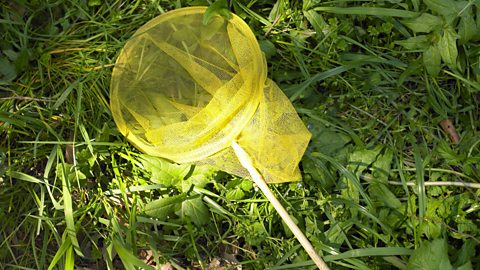Tools used for sampling
When sampling a population, the numbers of organisms are counted within a sample site, and then the results multiplied to estimate the total number in the entire habitat. Large animals and plants can often simply be counted. However, many smaller animals like insects and smaller mammals need to be trapped first so they can be counted and then released afterwards.
Collecting organisms
Organisms can be collected using a variety of methods, including:
- nets
- pooters
- pitfall traps
Nets and pooters
Nets are useful for collecting flying insects such as butterflies and moths. They are swept through long grass or leaves of trees in a process called sweep netting. The organisms are caught in the net. To catch aquatic organisms, nets are often held downstream of the area to be studied and then the riverbed is gently disturbed by the person doing the sampling. The small animals float into the net. This is called kick-sampling.

An insect sweep net
A pooterDevice used in ecological sampling to collect insects. is a small jar used for collecting insects. It has two tubes - one goes into your mouth so you can apply suction, and the other goes over the insect so that it is sucked into the jar. A fine mesh over the end of the first tube stops you swallowing the insect.

Pitfall traps
A pitfall trap is often used to sample small invertebrates living on the ground, such as beetles, spiders and slugs. The trap consists of a container, such as a yogurt carton, buried in the ground with the top of the container level with the soil surface. The sides are smooth to stop the organisms escaping. The top of the container is covered by a piece of wood with a slight gap to allow insects to climb in. It is important to check the trap regularly to avoid the organisms escaping or being eaten before they are counted.
Capture-recapture
One way to estimate the population size of an animal species is capture-recapture. Some animals are trapped, for example, using pitfall traps. They are marked in some harmless way then released. Traps are used a few days later. The numbers of marked and unmarked animals caught in the traps are recorded. The population size is estimated using this formula:
\(\text{Population size} = \frac{\text{number in 1st sample} \times \text{number in 2nd sample}}{\text{number in 2nd sample previously marked}}\)
For example, ten animals were trapped, marked and released. Two days later, 20 animals were trapped. Of these, five were found to be marked.
\(\text{population size =}\frac{10 \times 20}{5} = \frac{200}{5} = 40\)
When using capture-recapture data, you have to make assumptions including:
- there is no death, or movement of animals to other habitats
- the sampling methods used each time are identical
- the marking has not affected the survival rate of the animals
Using keys
When sampling a habitat, there is the possibility that a scientist will come across organisms that they do not recognise. In this case, the scientist consults a key. This has pictures and descriptions of organisms so that the scientist can compare what they see with the data in the key. A key will usually ask questions based on easily identifiable features of an organism. dichotomous keyA series of questions with only two answers that lead the user to the correct name of an item or organism. use questions to which there are only two answers. They can be presented as a table of questions, or as a branching tree of questions.
Branching tree example
This tree could help you identify a new vertebrate. For example, if it had no fur or feathers and dry skin, you would follow the right-hand pathway at the first and second junctions, but the left-hand pathway at the third junction. This would lead you to identify the animal as a reptile.
More guides on this topic
- Monitoring and maintaining the environment - OCR Gateway
- Feeding the human race - OCR Gateway
- Monitoring & maintaining health - Communicable diseases - OCR Gateway
- Treating, curing and preventing disease - OCR Gateway
- Monoclonal antibodies - Higher - OCR Gateway
- Plant disease - OCR Gateway
- Cancer and cardiovascular disease - Non-communicable - OCR Gateway
- Monitoring and maintaining health - Non-communicable - OCR Gateway
- Sample exam questions - global challenges - OCR Gateway